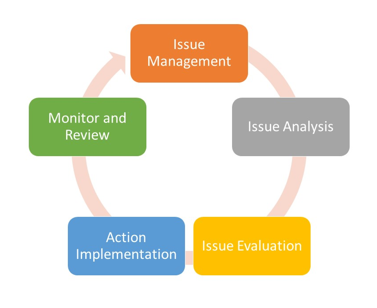The Project Management process is a cyclic process that involves the project development phases, resource allocation, and actual project completion activities. During the project completion aspects of the project management cycle, allocations are usually made for unexpected project delays. Knowing that there is no perfection, project managers ensure that the appropriate time allocation is available for any authorities to correct any underlying issues that may arise in the process of delivering the customer requirements. Project issues are defined as risks that have an associated planned approach for their rectification.
When a project issue is identified, it is ideal for a systematic process to exist that facilitates the appropriate elimination of the hindrance. Utilizing lean systems, it is best for these issues to go through a five step process of Issue Identification, Issue Analysis, Issue Evaluation, Action Implementation, and finally the Monitoring and Review Process. Designed much like the daily management systems that we are so used to in the Lean System, in Project completion the Issue Management System aims to ensure that our target of zero issues has been readily achieved by the project team.
With appropriate Issue Management, a stable and efficient project completion will be attained throughout the project’s lifecycle. With the appropriate foresight, critical action can then be taken to ensure that the barriers to project completion are appropriately eliminated. In the course of a project, the root causes of the project hindrances will indeed vary, but it is in the systematic process that all solutions will ultimately be attained. Just like a plane navigation system, which tends to be off course approximately ninety percent of the time, via the appropriate control processes, the set point will always be returned to by the project team if they follow their issue management system.
The issue management system also provides an appropriate means via which the issue resolution process can be appropriately analyzed and documented for future learnings by the project team. With each project iteration, the process becomes easier and the completion activities are completed in a faster time frame. With faster completion times comes the appropriate reduction in allocation of resources, bringing much needed cost savings to the supporting sponsoring organization.
ISSUE MANAGEMENT
Via the Issue Management process the following five steps are implemented in an appropriate Issue Management System:
Issue Identification: When an issue arises during a project management activity, the first step is to log the issue so that it can be further discussed by the relevant assessment teams on the project team during a problem solving session.
Issue Analysis: Using the appropriate tools, such as a problem solving A3, the challenge at hand can be appropriately analyzed in terms of severity of impact on the current project activities.
Issue Evaluation: Analysis of the problem often leads to its root cause. Typically using a method such as a Fishbone Diagram, or a Pareto Chart, the severity of the identified problems from the analytical phases of the project can be compared with each other. The largest impactors will influence the creation of an action plan that will rectify the issues at hand.
Action Implementation: The project team is challenged with the task of completing the prescribed project for the purpose of improving the organization’s future operations. The project issue is a hindrance to project completion and must be rectified as soon as possible, or else the project can run into time and cost over-runs. An appropriate project action completion checklist is created, and acted on over time.
Monitoring and Review: As with all lean processes, what gets measured gets managed. The relevant responsible parties will respond to the project manager as the hindrances are overcome. This activity concludes or feeds into the feedback loop of the Issue Management System.
Issue Management System Best Practices and System Conclusions
The lean system is a continuous feedback loop that ensures that the appropriate system targets are being met. When there are critical challenges, or issues seem not to be progressing past a critical point, systems must be put into place that will ensure that the appropriate escalation in a chain of command can be implemented. This is akin to a reaction plan.
A suitable example includes the building of any commercial system such as a pump system. If a lower level operator cannot manage the process of constructing the system, the matter would then be escalated to the system mechanical engineers to facilitate the appropriate fixes. With the higher level understanding, the system mechanical engineers will then be able to facilitate the problem solutions and progress the project. The pulling on the chain of command, ensures that the problems are always talked about until they are resolved.
Along with escalation of the project issues, other common practices in issue management such as documentation, pareto analysis and any other problem solving methodology built into the lean system, will ensure that project system is running as smoothly as it should. With the lean principles applied in a systematic fashion, project completion will always be smooth, as a solution-oriented approach to the project will easily be in place. Try this today on your projects, and you’ll be pleased with the final results and the way your projects are optimized.

